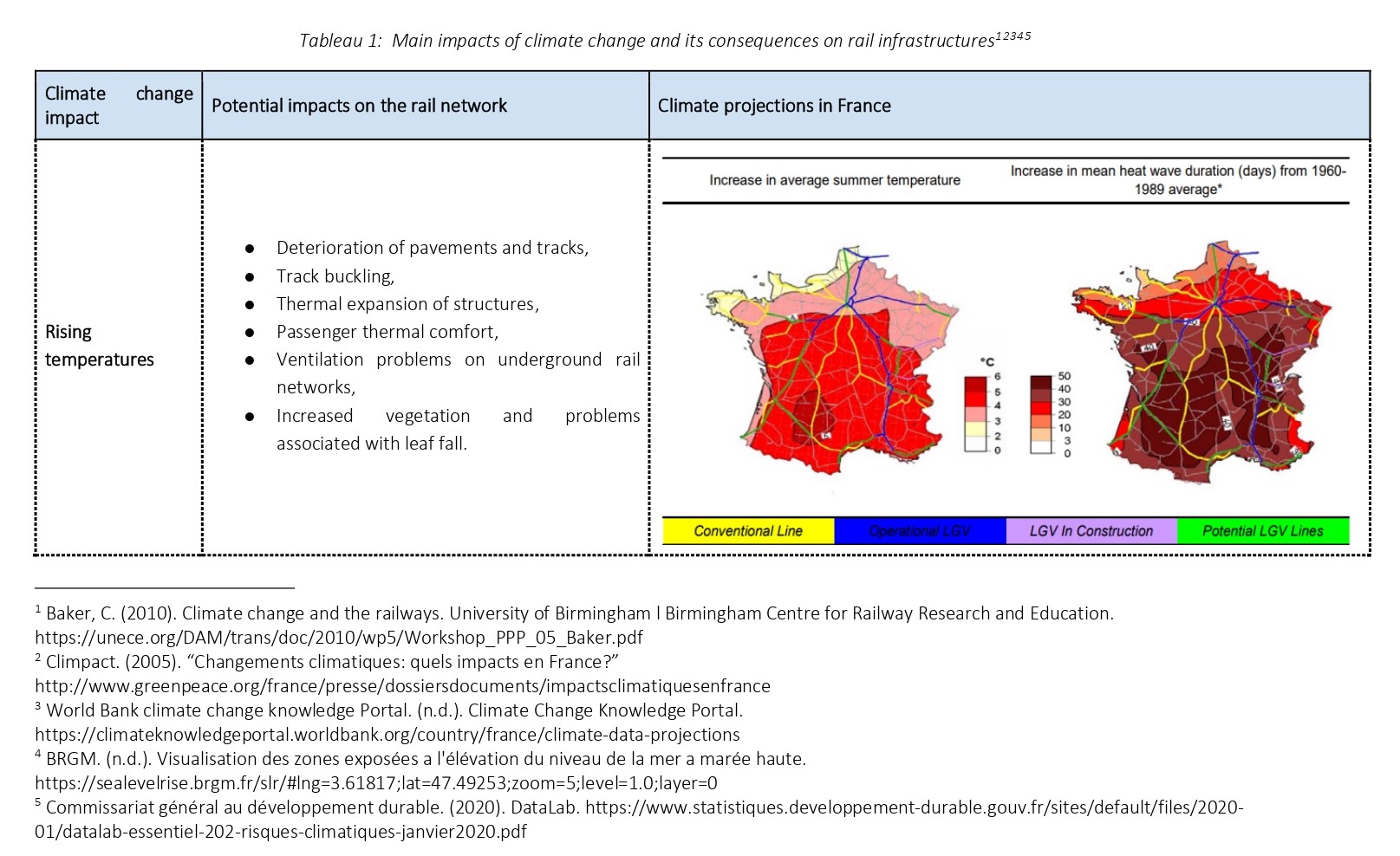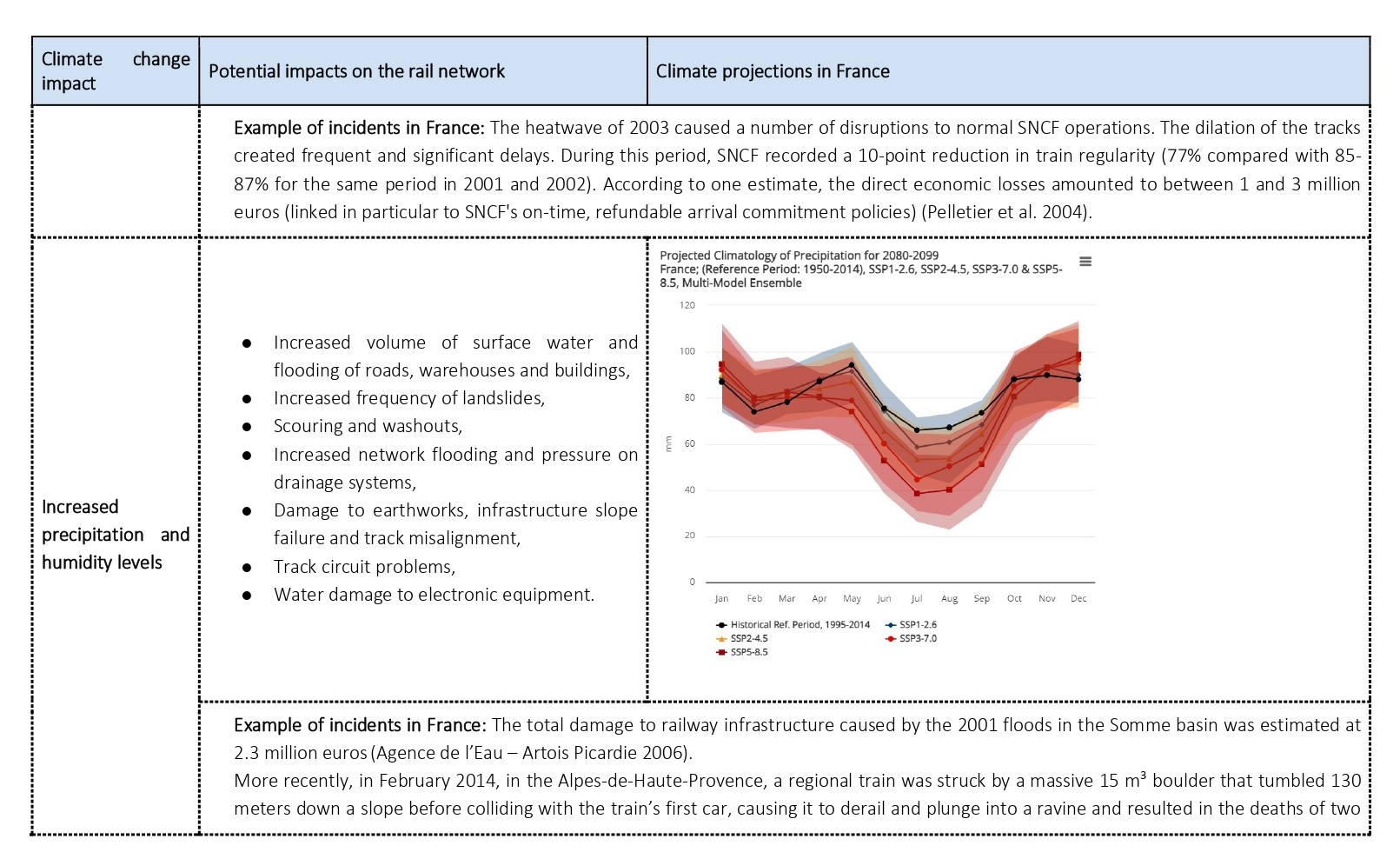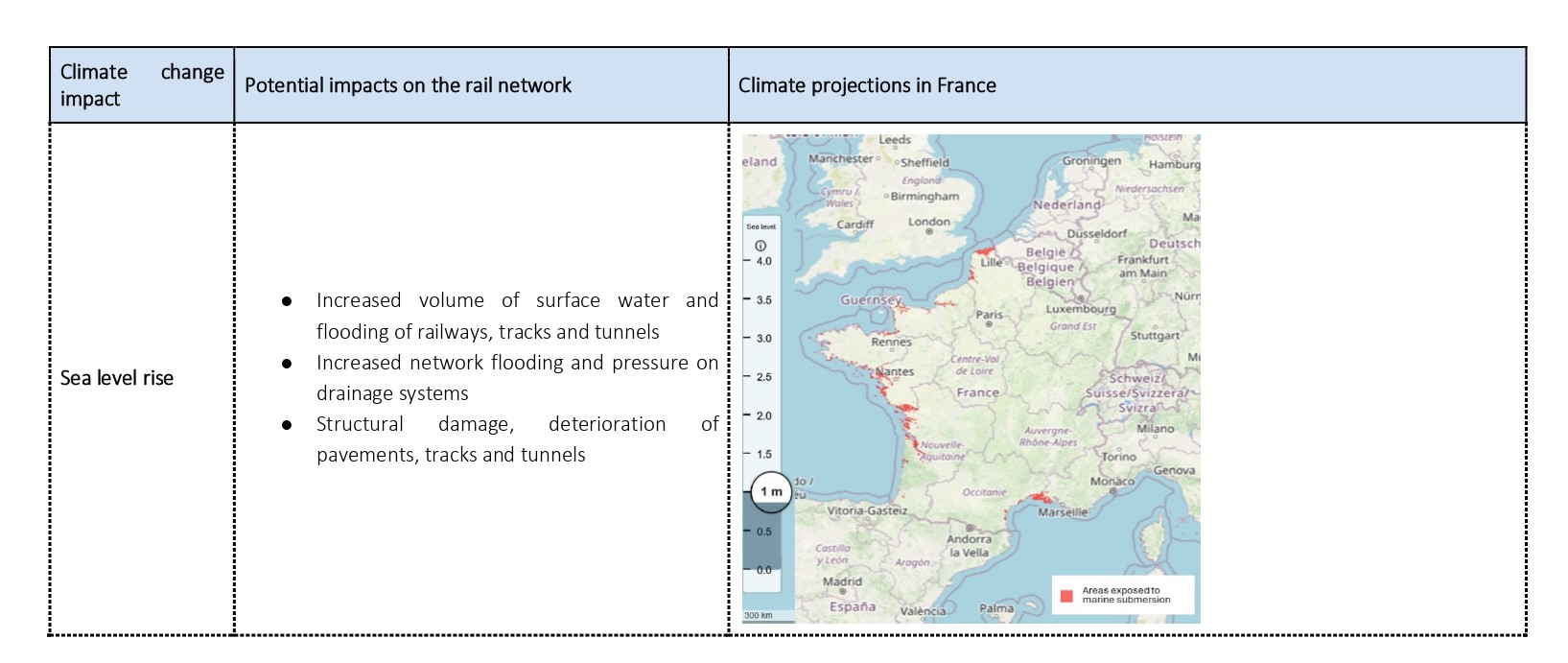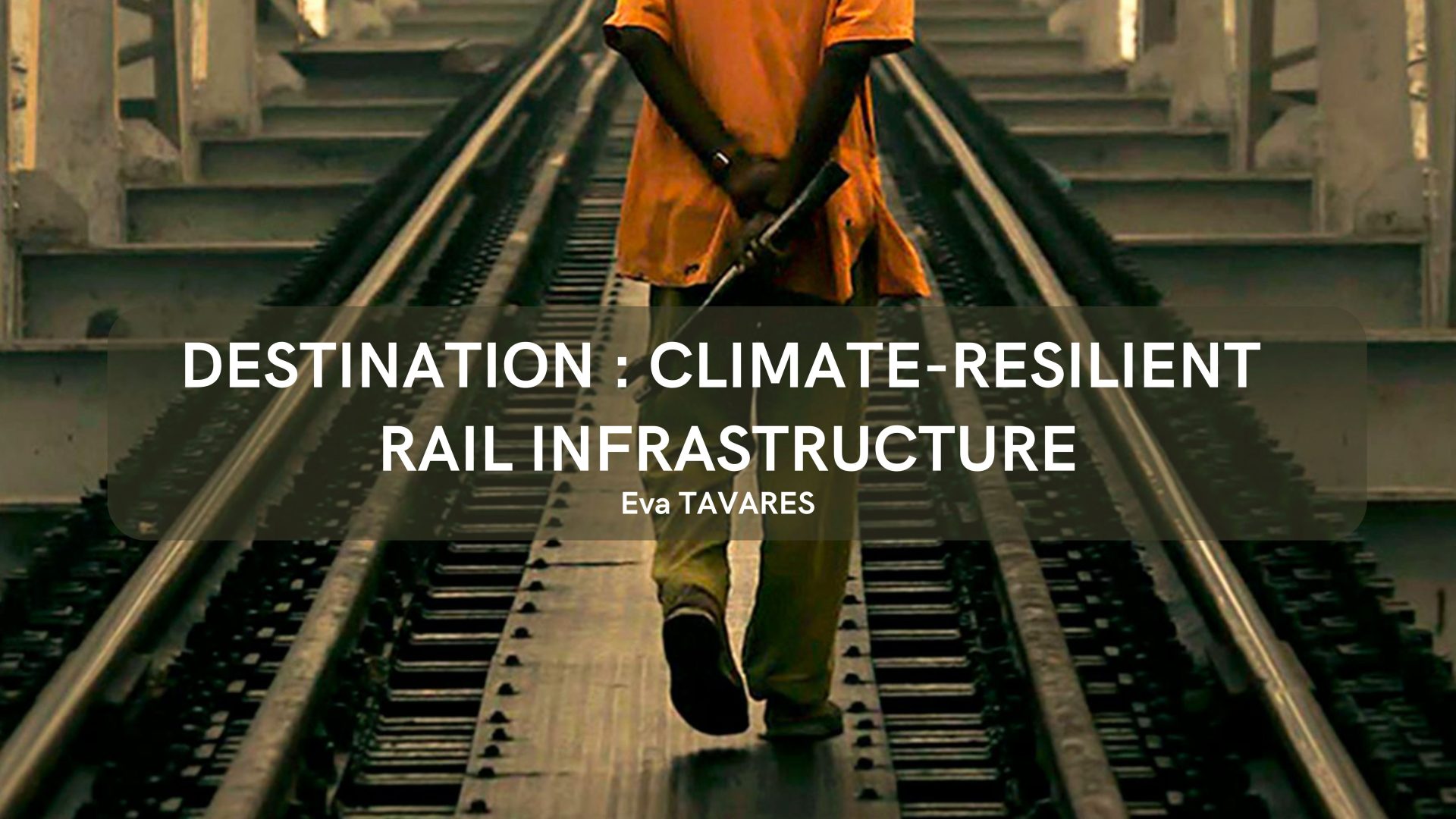Article de Eva Tavares (MS EnvIM 2023-24)
Introduction
Imagine embarking on a train journey travelling through scenic landscapes only to face unexpected stops or delays due to weather disruptions. As climate change intensify, no sector is spared. Over the past few decades, transport infrastructures around the world have faced unprecedented challenges. Every journey, once predictable, now is exposed to extreme weather events that create vulnerabilities in rail networks. Extreme weather phenomena such as floods, storms and heat waves are increasingly disrupting operations, affecting reliability, safety, and travel speeds (Cochran 2009).
The impact of climate change on transport infrastructures is a particularly important factor to take into account, given that they are operated up to century and are vital for the social cohesion and economic dynamism (Kahrl et Roland-Holst 2008). Due to their low-carbon emission and long-lifespan, railway infrastrucures can be a key to sustainable mobility, but only if these networks can adapt to climate change impacts.
According to a study estimating hazard exposure of road and rail infrastructures, around 27% of such assets worldwide are exposed to at least one climatic hazard (Koks et al. 2019). The estimated annual cost of direct damages to road and rail infrastructure ranges from 3.1 to 22 billion US dollars worlwide. In some countries, they reach up to 1% of the GDP per year. In a context of societal transition in which rail networks can plays a pivotal role in low-carbon development, it is crucial to understand the impact of climate change on those infrastrucutres, why they are particularly vulnerable and how their resilience can be strengthened.
The French railways
To grasp how climate impacts rail travels, the French rail network has been selected, it is the second largest network in Europe. Stretching over 53,000 kilometers across urban centers, mountain valleys, and coastal lines, France’s network represents the diverse challenges railways face. It is one of the 20 countries with the highest estimated annual multi-risk damage in absolute terms. Indeed, over the period 2015 to 2022, significant rail accidents linked to climatic hazards have tripled. One such event was recorded in 2015, compared with nine in 2019 (Etablissement public de sécurité ferroviaire 2023).
The extent and intensity of the impact of climate change are highly dependent on location and contextual characteristics. Although some regions, such as Hauts-de-France and Provence-Alpes-Côte d’Azur, are particularly affected by the consequences of climate change, all French territories will be impacted (XDI 2023).
What are the main impacts and consequences of climate change on rail infrastructures ?
The main impacts and consequences of climate change on rail infrastructures are summarized in the table below.



 For travelers, these incidents are more than disruptions, they are reminders of the vast interdependencies within rail networks. The interdependence of rail networks is due to interconnection, complementarity and cooperation between national, regional and local rail systems. For example, storms can affect national and international networks, causing multiple infrastructure failures and sometimes triggering chain reactions. This phenomenon was illustrated on January 18th 2018, when a severe storm forced the shutdown of the rail network in the Netherlands, also causing delays and disruption to services in Germany and the United-Kingdom (Henley 2018).
For travelers, these incidents are more than disruptions, they are reminders of the vast interdependencies within rail networks. The interdependence of rail networks is due to interconnection, complementarity and cooperation between national, regional and local rail systems. For example, storms can affect national and international networks, causing multiple infrastructure failures and sometimes triggering chain reactions. This phenomenon was illustrated on January 18th 2018, when a severe storm forced the shutdown of the rail network in the Netherlands, also causing delays and disruption to services in Germany and the United-Kingdom (Henley 2018).
In France, delays and disruptions are increasingly common for SNCF passengers, with weather events accounting for 19% of all travel time lost on SNCF’s network in 2022, the first cause of network disruptions (Palin et al. 2021). Between 2019 to 2021, the main causes of incidents were strong winds and thunderstorms (41%), heavy rain (21%), followed by frost and snow (20%) and extreme heat (12%) (Cour des comptes 2024).
Vulnerable infrastructures
One of the reason for the high vulnerability of those networks lies in their aging infrastructure and longlifespan. For the frequent rail travelers, aging infrastructure becomes an unavoidable aspect of the journey. The construction of railway infrastructure and rolling stock was initially designed for long-term durability, relying on design and construction standards based on relatively outdated and often empirical climate data.
As a result, those infrastrutures have beend designed in an era where climate change was not well understood and not a prioroty for railway companies. Consequently, as climate conditions shift, the vulnerabilities of these infrastructures and materials have increased and will continue to increase with climate change.
Railways are rigid and immovable infrastructure with limited capacities for intrinsic adaptation, especially as some tracks traverse particularly vulnerable environments. In France, a significant portion of the railway network runs through mountainous and coastal landscapes, currently exposed to intensifying risks that were far less severe when these networks were originally designed. As you travel trhough coastal network, it’s unsettling to think that these tracks might be submerged due to rising sea levels or face operational stops due to landslides triggered by heavy rains. Railway construction being costly, those networks can difficulty be relocated in safer zone, as a result their functioning rely only on adaptation measures.
Given their importance to human society, and the timescales over which infrastructure choices are made, it is therefore important to understand what measures can be defined to reduce the impact of climate change. Those measures depend on the characteristics of the project and its lifecycle (maintenance, renewal or development) (Autorité de régulation des transports 2023).
Adaptation process
Adaptation is an iterative process particularly difficult to graps as it is necessary to take into account climate vulnerabilities of the whole system, including interdependencies. There are several ways to take these risks into account during the life cycle of transport networks (Autorité de régulation des transports 2023) :
- Resilient infrastructure planning and design (development phase): for new infrastructure projects, climate change resilience and adaptation criteria can be defined. Based on local future climate projections, it is possible to define measures for mitigating and adapting infrastructures to different territorial risks.
- Adaptation of existing infrastructure (renewal phase): in order to reduce the impact on existing infrastructure, railway companies can plan projects to renovate and modernize existing infrastructure to make it more resistant to extreme weather conditions. Depending on the territories concerned, these projects may include installing dikes along the track, improving drainage networks, and reinforcing pavements and track
- Monitoring and preventive maintenance (maintenance phase): to keep rail networks running smoothly and ensure their long-term resilience, monitoring and maintenance measures can be put in place. These measures incorporate monitoring systems to detect signs of infrastructure deterioration at an early stage and take concrete preventive action. This can include the use of sensors to monitor the condition of tracks and bridges in real time. de capteurs pour surveiller l’état des voies et des ponts en temps réel.
These adaptation and mitigation measures for transport systems do not necessarily require direct engineering or technological interventions (“gray” or “hard” interventions) on infrastructures. Regulatory and policy adaptations (“soft” measures) that improve management, communication and response to extreme events within and between organizations are also extremely important, and are a step towards “transformational” adaptation (Autorité de régulation des transports 2023).
Although necessary to ensure the resilience of transport infrastructures, the implementation of technical and policy measures remains limited, as they face multiple challenges. One of the main complexities in adjusting to climate change lies in the uncertainty surrounding its impacts at local and regional level. It is complex to assess the risks associated with climate change, and the economic consequences of these variations (hasard uncertainty, uncertainty as to the future evolution of GHG emissions, modelling uncertainty, natural climate variability, etc.) (Palin et al. 2021).
On top of this, there are internal obstacles within railways companies themselves, such as processes and procedures that are not adapted to an uncertain dynamic phenomenon, and which prevent companies from adapting effectively to climate change. It is particularly prevalent in the rail systems are, depending on local specifieties, can involve a high numbers of actors (railways companies, local governements, national agencies) as networks are usually composed of regional and national lines (Department of transport 2024).
Conclusion
The good news is that several railway companies, including those in France and the UK, have begun implementing a combination of hard and soft measures to adapt to climate change align with the European Green Deal (European Environment Agency 2024). In the future, your train may now cross a flood-prone valley on elevated tracks or rely on drainage systems designed to handle events that would have been unthinkable a few decades ago.
As the train journey of climate adaptation continues, it becomes evident that every step forward in rail resilience is essential to ensure that railways can withstand the uncertainties of climate change and move toward sustainable mobility despite diffilult challenges, particularly for developing countries who already struggle to develop infrastrucure networks.
–
Bibliography
Agence de l’Eau – Artois Picardie. 2006. Evaluation Economique des Dommages Lies aux Inondations.
Autorité de régulation des transports. 2023. Scénarios de long terme pour le réseau ferroviaire français (2022-2042).
Cochran, Ian. 2009. Climate Change Vulnerabilities and Adaptation Possibilities for Transport Infrastructures in France. Issue n°18. CDC CLIMAT.
Cour des comptes. 2024. L’adaptation du réseau ferroviaire national au changement climatique.
Department of transport. 2024. Fit for a changing climate? Adapting the UK’s transport system.
Etablissement public de sécurité ferroviaire. 2023. Etude d’impact des risques liés au changement climatique sur l’exploitation ferroviaire – précurseurs, méthodes et premiers résultats. EPSF.
European Environment Agency. 2024. « Transport ». Climate ADAPT. Consulté (https://climate-adapt.eea.europa.eu/en/eu-adaptation-policy/sector-policies/transport).
Henley, Jon. 2018. « Deadly gales halt trains and flights across north-west Europe ». The Guardian, janvier 19.
Kahrl, Frederich, et David Roland-Holst. 2008. California Climate Risk and Response. Research Paper No. 08102801. Univeristy of California Berkeley.
Koks, E. E., J. Rozenberg, C. Zorn, M. Tariverdi, M. Vousdoukas, S. A. Fraser, J. W. Hall, et S. Hallegatte. 2019. « A Global Multi-Hazard Risk Analysis of Road and Railway Infrastructure Assets ». Nature Communications 10(1):2677. doi: 10.1038/s41467-019-10442-3.
Palin, Erika J., Irina Stipanovic Oslakovic, Kenneth Gavin, et Andrew Quinn. 2021. « Implications of Climate Change for Railway Infrastructure ». WIREs Climate Change 12(5):e728. doi: 10.1002/wcc.728.
Pelletier, Jacques, Valérie Létard, Hilaire Flandre, et Serge Lepeltier. 2004. La France et les Français face à la canicule : les leçons d’une crise. Rapport d’information n° 195. Sénat.
XDI. 2023. 2023 XDI Gross Domestic Climate Risk Report. Cross Dependency Initiative.

